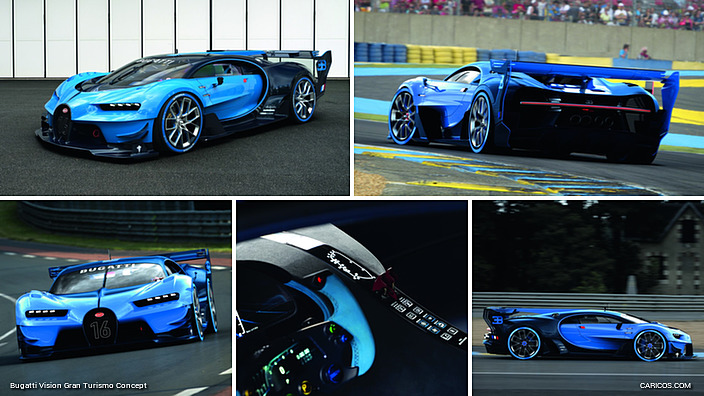Bugatti Vision Gran Turismo Concept
A unique show car makes its world debut: Bugatti has transformed its Bugatti Vision Gran Turismo from the virtual world of bytes and pixels into a real carbon-fibre racer specially for the 66th International Motor Show (IAA). In Frankfurt the French super sports car brand unveils the project that it has designed exclusively for the PlayStation video game franchise Gran Turismo to thank its millions of fans worldwide for their loyalty and enthusiasm. Following the sale of all 450 vehicles in the Veyron series, Bugatti Vision Gran Turismo marks a new chapter in the luxury brand's history that will culminate in the unveiling of the new Bugatti super sports car. The Bugatti Vision Gran Turismo design pays homage to Bugatti's great racing tradition of the 1920s and 1930s, in particular its victories in the 24 Hours of Le Mans race, and is based on cutting-edge motor sport technology. At the same time the virtual project also previews Bugatti's future design language.
"Bugatti Vision Gran Turismo is the first stage on a new journey that Bugatti is embarking on following the successful completion of its Veyron chapter, and which will culminate in the unveiling of the next Bugatti super sports car in the not too distant future," says Wolfgang Dürheimer, President of Bugatti Automobiles S.A.S. "This project showcases Bugatti's new design language, which we have developed to celebrate this new chapter in our company history."
"Bugatti will remain clearly positioned in the future as a brand with a strong profile," continues Dürheimer. "We're building the world's fastest, most exclusive, most luxurious and most powerful production super sports car."
 2015 Bugatti Vision Gran Turismo Concept
2015 Bugatti Vision Gran Turismo Concept
The collaboration with Polyphony Digital, creator of Gran Turismo, allows Bugatti to make the highly exclusive brand available to fans, gamers and high-performance aficionados of all ages. The PlayStation video game franchise has sold over 70 million units since its launch in 1997.
"Our Veyron series was limited to 450 vehicles, all of which are now owned by proud automotive connoisseurs," says the Bugatti President. "However, our fans, who love the brand and have remained loyal to us for years throughout the world, are unlimited in number. This project is our way of thanking them for their loyalty and enthusiasm."
"Having met the team at Bugatti, I can honestly say that the way they challenge limits, the way they try to push beyond boundaries, feels so similar to the way Gran Turismo attempts to go the extra mile in everything it does”, says Kazunori Yamauchi, Senior Vice President of Sony Computer Entertainment and President of Polyphony Digital, who has created the world’s most successful video racing franchise. “For us, the Bugatti Vision Gran Turismo greatly enriches the Gran Turismo offering. It is an exciting and cool car and I am proud to have it on board“.
Bugatti Vision Gran Turismo gives an outlook of the brand's future form and design language
The Bugatti Vision Gran Turismo virtual concept previews the design language that the brand has developed for the next chapter of its history following the end of the Veyron era.
"Bugatti's design DNA has reached a new stage in its evolution," says Achim Anscheidt, head of the Bugatti design team. "Given the nature of the project, our concept car for Vision Gran Turismo is overstated and pushes performance to the limits, but its progressive design language will clearly show the direction that Bugatti's design will take in the coming years."
Design of virtual race car pays homage to Bugatti's racing tradition
The Bugatti designers drew their inspiration from the brand's illustrious racing tradition. Bugatti enjoyed great success in racing in the 1920s and 1930s. Company founder Ettore Bugatti was the first car maker to build street-legal versions of his compact and lightweight race cars, which he sold successfully to amateur racing drivers following victorious weekends on the track. The Type 35, probably the most successful race car of all time with over 2,000 victories and podium finishes in its day, is the most prominent example of that phenomenon and continues to embody Bugatti's racing legacy.
Historical inspiration for the modern virtual race car for Vision Gran Turismo came, in particular, from the Bugatti Type 57 Tank and its victories in the 24 Hours of Le Mans races in 1937 and 1939. The Bugatti Vision Gran Turismo will race in the classic blue two-tone finish of the Type 57 G Tank, which was the winning car in 1937, while also evoking the colour of the historic French race cars of that time. Blue has been the Bugatti brand colour ever since.
"Le Mans influenced the design of the virtual race car for Vision Gran Turismo in two ways," continues Anscheidt. "First, through Bugatti's tremendous victories on the circuit there. Second, this track with its long straights remains an emblem of top speed today, making it the ideal place for Bugatti to show what it can do as a double world record holder." Bugatti has held the record for the world's fastest street-legal production vehicle since 2010 with a speed of 431.072 kph (267.86 mph) and made its way into the record books again in 2013 with the world's fastest production roadster, clocking 408.84 kph (254.04 mph).
Bugatti designers and engineers developed the virtual race car in close collaboration
Although the Bugatti Vision Gran Turismo will race in a class in which the racers typically bear no or little relation to actual cars and whose design is therefore far more extreme and performance-geared than that of street-legal cars, two points were important to the design team: first, the virtual car should have the distinctive Bugatti look and embody Bugatti's values of "Art, Forme, Technique", and, second, every vehicle component should have a real performance function. The virtual race car was therefore developed in close collaboration with the Bugatti engineers and is based on cutting-edge racing technology and aerodynamic analyses.
Florian Umbach, head of chassis development at Bugatti, had a lot of fun with the project. "For Bugatti Vision Gran Turismo, we've geared every parameter to maximum performance, unlike with our production car, where it goes without saying that comfort and easy handling are also key factors." The systems that are responsible for luxury and comfort in the street-legal Bugatti super sports car have been dispensed with for the Bugatti Vision Gran Turismo. That makes the vehicle more lightweight and creates space for the new, high-performance aerodynamics and a new radiator layout that we specifically designed for the virtual race track.
Nevertheless, the car's technical features, like its design, are realistic, since the virtual project is based on the Bugatti development team's latest simulation models of driving dynamics and aerodynamics. The engineers and the designers worked together meticulously on the project for six months. Also, racing experts from the Volkswagen Group were involved to ensure that every detail of the virtual race car is authentic.
"For Bugatti Vision Gran Turismo, my colleagues and I for once were free from the statutory requirements that as vehicle developers we naturally need to comply with in everyday life," continues Umbach. "It was an exciting project without any limits or compromises. We were only bound by the safety regulations of the FIA."
The engineers have calculated that the Bugatti Vision Gran Turismo can drive at over 400 kph (250 mph) on four sections of the virtual Le Mans track. "With our extreme speed on the long straights, we could make up for any disadvantages on the bends, and would then be as quick in the virtual world as the fastest real-life LMP1 race car, which, unlike us in the video game, naturally needs to comply with all FIA and ACO regulations," explains Umbach.
To attain that performance goal, the Bugatti Vision Gran Turismo too is driven by a W16 engine, which delivers incredible power to all four wheels.
"While the Bugatti Veyron is a super sports car that's a combination of the beauty and the beast, the Bugatti Vision Gran Turismo is the ultimate performance beast," says Anscheidt. "With its radical and extreme design, it's a thoroughbred Bugatti for the virtual race track."
Exterior design: a successful symbiosis of technology and aesthetics
"We wanted to make the project as realistic as possible for our fans, and to introduce a real Bugatti to the virtual world of the PlayStation video game franchise," explains Frank Heyl, head of exterior design for production development at Bugatti. "Every design feature has a purpose. Bugatti Vision Gran Turismo is a successful symbiosis of technology and aesthetics."
"To pay homage to the victories in Le Mans, we definitely wanted to design a modern vehicle to convey the atmosphere of those special moments in Bugatti's history, rather than create a retro-style race car," explains Sasha Selipanov, head of exterior design creative development. "As an unabashed Gran Turismo fan, it's a great adventure for me to bring a brand that was once so successful in racing back to the virtual track.
The expressive design of the Bugatti Vision Gran Turismo is marked by large convex surfaces, which contrast with concave transitions and strong lines. That lends the exterior styling precision and surface tensions of the highest quality. The proportions of the vehicle are uncompromisingly athletic and designed for maximum performance. The cockpit lies as lowslung as possible between the four dominant wheel housings and is fully enclosed by the muscular wings. The extreme mid-engined proportions with the V-shaped front end and short rear overhang indicate powerful forward thrust even when stationary. The result is a dynamic, "ready-to-race" stance that gives the impression of immense power immediately at the ready.
The designers have unmistakeably integrated the key features of the Bugatti design DNA into the virtual race car's design. The side profile of the Bugatti Vision Gran Turismo features the famous Bugatti line, which not only divides the exterior into the signature two-tone finish, but also plays an important aerodynamic role in cooling the vehicle.
The virtual race car also features the most striking Bugatti symbol – the horseshoe on the front grille. It is positioned in the centre of the central front air intake as a three-dimensional sculpture, and acts as a support for the front splitter. The horseshoe is flanked by the eight-eye headlights, which were specially developed for Bugatti Vision Gran Turismo. They also have an aerodynamic function, since they act as air intakes to cool the brakes.
Another signature Bugatti design element is the centre fin, which derives from the legendary 1936 Type 57 Atlantic. The designers have used two versions of the fin for the Bugatti Vision Gran Turismo: one on the wings and rear side panels, where the fins enhance the design of the vehicle and the other running the length of the roof, where the fin makes an important contribution to the car's dynamic stability. The kinematic system for the rear wing, which controls the air brake and the drag reduction system (DRS), is located here.
An interesting detail on the roof is the NACA duct, which, with its contrasting light blue finish, is not only strikingly aesthetic, but is also the most aerodynamic way to bring air into the engine at roof level without creating turbulence in the inflow of the rear wing.
The rear of the vehicle has a strong trailing edge which provides excellent driving stability, exhausts the hot air from the engine compartment and, no less importantly, unmistakeably shows the virtual competitor that a Bugatti is getting ahead and away from them.
Functional, exclusive interior design à la Bugatti
Just as with the exterior, no comprises were made when it came to the design of the vehicle's interior. "It's the ultimate race car, and at the same time a true Bugatti," says Etienne Salome, head of interior design at Bugatti.
The architecture of the interior continues the clean lines of the exterior. The striking centre fin of the roof is echoed in the interior, where it divides the cockpit from the rest of the interior and merges with the central console below. The interior picks up the two-tone finish of the outer shell.
Every aspect of the interior is geared to racing. All indicators, displays and controls, which are positioned where a racing driver would expect them to be, are easy to read and can be reached in a split second.
There are two displays for the driver, both of which are convex for improved readability in line with state-of-the-art design. The display on the steering wheel shows all the relevant vehicle information. The second display is located on the steering column and combines the images from the three cameras mounted on the exterior of the vehicle to provide the driver with a better overview for an even safer driving experience.
All displays in the cockpit are backlit so the driver can see the information easily. The materials used for the interior also reflect Bugatti's values. The designers followed the principles of authenticity and exceptional quality. The Bugatti Vision Gran Turismo not only uses carbon fibre, which is typically used in racing to keep the cars lightweight, but blue visible carbon fibre. A high-gloss version is used for the exterior, whereas a matte finish is used in the interior to prevent unwanted reflections.
The Bugatti designers went the extra mile with the leather upholstery as well. A particularly lightweight and durable suede that until now was used only for racing shoes in Formula One has been used for parts in the cockpit that need to have a particularly good grip or be resilient such as the steering wheel, the dash panel and the headrest. Bugatti Vision Gran Turismo is the first vehicle to be upholstered with that material.
"Whether in the virtual or in the real world, a Bugatti needs to exude the values that the brand stands for," say the designers. The show car in Frankfurt is therefore the perfect realisation of the virtual concept. It was built by hand, using exclusive materials, with Bugatti's signature attention to detail and workmanship.
The Bugatti Vision Gran Turismo show car will be on display at the Bugatti stand in hall 3.0 of the IAA grounds from 17 to 27 September 2015.














